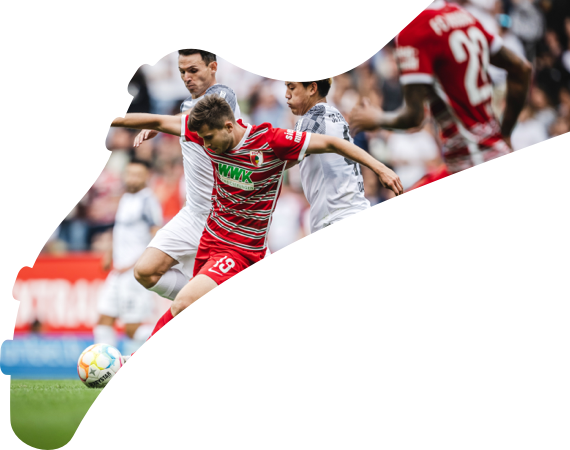
Are Timo Werner, Erling Haaland and Robert Lewandowski among the best Bundesliga strikers of all time?
The goal-hungry Bundesliga is barrelling towards the 1,000-mark for the season, with its frontline specialists unsurprisingly leading the way. Reason enough to cast an eye back on how the role of the classic centre-forward has evolved over the years, from Gerd Müller to Erling Haaland, via Miroslav Klose and Robert Lewandowski.
Müller was arguably the league's first true superstar, his goalscoring feats for Bayern Munich unmatched both before and since his heyday in the 1960s and 70s.
Still the league's all-time top scorer with 365 goals spread across an astonishing 15 years at the club, Müller also holds the scarcely believable records for most goals in a single campaign (40 in 1971/72) and most Torjägerkanonen (seven) - the prize awarded to the top scorer in a season - and played a leading role in making Bayern the powerhouse they are today.
"Gerd Müller was a phenomenon, he scored so many goals," Bayern and Germany legend Franz Beckenbauer once told UEFA. "Thank goodness he scored them for Bayern and the German national team. Without him I don't think we'd have won the European Championship or the World Cup; you need players like him,"
But exactly what kind of player was he? Standing at just 5'9" with a stocky frame and muscular thighs, he was physically no match for hulking centre-backs when it came to holding the ball up or needing a target man.
However, that stature gave him a low centre of gravity, allowing him to swiftly turn and shoot all in one go – a move that became his trademark. Deceptively quick and with an incredible leap - thanks to those thighs - he was virtually unplayable in his prime.
Furthermore, he was a real fox in the box, possessing the poacher's instinct of being in the right place at the right time. "Something inside your head says, 'Gerd, go this way, or Gerd go that way,' and I go," he said by way of explanation.
"Nobody had a better understanding of how to score goals," Beckenbauer said. "His speed was unbelievable. I would play against him in training and I never had a chance. We knew the runs he would make but we still couldn't stop him - he was just too quick."
Müller eventually left Munich in 1979, one year after Miroslav Klose was born - the man who perhaps comes closest to rivalling him as the country’s greatest striker.
Watch: The best of Klose!

'Miro' was a very different type of player though. Where Müller was squat and compact, Klose was 6'0"-tall and lean. Klose's predatory instincts were similarly highly tuned though - he never scored from outside the penalty area - and he also had the knack of timing runs to perfection and being a beast in the air.
Where he differs from Müller, however, is that he was also more involved in the build-up play, rather than simply providing the sharp end of the spear. Klose was the ultimate team player, happy to drop deep or out wide as the situation required; his 80 assists in 307 Bundesliga outings are testament to this.
"Miro was already in the national team when I joined the DFB as assistant coach in 2004," Joachim Löw recalled after the pair won the World Cup in Brazil in 2014.
"So we've now spent 10 years working together. His aerial strength, presence in the penalty area, understanding of the game and tireless commitment are without equal, and yet I have rarely encountered a player so down to earth, modest, fair, professional, reliable and team-spirited."
Klose also struck 121 Bundesliga goals all told, while his legacy at international level is arguably even greater: he is the all-time top scorer in FIFA World Cup history with 16 goals, having overtaken Brazilian legend Ronaldo (15) and Müller (14) at that 2014 showpiece.
"Miroslav is a great player," purred former Germany international Karl-Heinz Riedle of his compatriot during his Bayern days. "He's complete."
That was undoubtedly true, but equally certain is that current Bayern forward Lewandowski has raised the bar even further. Combining Klose's all-round game and understanding with Müller's in-built nose for goal and an impressive physique, the Polish forward has redefined what it means to be a striker.
Watch: A tactical analysis of Robert Lewandowski!

He is the archetypal modern centre-forward, surely the best in the world in his position. The 31-year-old can do it all, weaving silky technique with steely strength and a killer eye for goal.
Lewandowski has had the most shots (110) and scored the most goals (25) in the Bundesliga this term and leads the European scoring charts with 39 in all club competitions. He may be out injured for another few weeks, but only a fool would rule him out of the running for what would be a fifth top scorer's cannon.
"Lewandowski has a very good mix of the classic striker traits in the box and being a danger from crosses," analysed RB Leipzig coach Julian Nagelsmann of the Bayern forward, who is also an expert at shielding the ball from defenders and is a dead-ball specialist at free-kicks and penalties.
"He's incredibly strong in the air, has a turn of pace, but he's also super when he plays between the lines. He can play as a No.10 and doesn't just have to put the final touch on moves but can also play the final pass. It's just extraordinary."
Although he is now 31, there is still a lot of life in Lewandowski's Bundesliga career – even if his potential successors are already making names for themselves.
Chief among them is Borussia Dortmund forward Haaland. The 19-year-old has only made seven league appearances for Die Schwarzgelben so far, yet his talent and technique are there for all to see – as is his finishing ability: he has nine Bundesliga goals already.
In the injury-enforced absence of Paco Alcacer prior to the winter break, Dortmund experimented with various players up front in a false 9 role - Mario Götze, Marco Reus, Julian Brandt - but with mixed results.
Watch: The role Haaland plays in Dortmund's deadly attack!

But now that they have the real deal, a genuine and remarkably talented No.9, with players queuing up to put him through on goal, Dortmund could be set for a memorable second half of the campaign.
Standing at 6'4"-tall, powerfully built, willing to drop deep and track back, as well as having incredible acceleration, the Norway international looks like a natural heir to Lewandowski's throne. "He fits the Dortmund game between the lines," Klose observed.
Leipzig forward Timo Werner is another player blessed with turbo-charged pace, and he is currently second only to Lewandowski this season in the Bundesliga scoring charts with 21 goals.
Watch: A closer look at how Timo Werner is scoring so many goals!

And although Werner also shares many traits with the fellow forwards on this page, it is perhaps he more than any other who is the most flexible, able to drift away from the centre for the good of the team.
"I think that assists are one of my strengths," the Germany international told bundesliga.com. "You're always defined as a striker by how many goals you score, but now I play a new position under the new coach.
"I'm playing almost as an attacking midfielder, which means I've got to play like the others do, like Emil Forsberg, Marcel Sabitzer, Christopher Nkunku, and get assists. Naturally, I've got to always link it all together. We've got to get beyond this image of me being the team's goalscorer."
The game may have evolved from the days of Müller and even Klose being penalty-box foxes, but Lewandowski now, and surely Werner and Haaland later, are proving - in their own ways - that they are as good as anyone out there.
Related news

Bundesliga Matchday 18 teams
The spotlight will be on Marvin Ducksch on Sunday as Bremen seek a first win of 2025 that could lift them as high as sixth.

5 reasons Leverkusen will beat Atlético
In-form Bayer Leverkusen take impressive domestic and European runs to the Spanish capital, where victory could propel Xabi Alonso's men to the knockout stages.

Hamburg strike late to leapfrog Cologne
Ransford-Yeboah Königsdörffer's effort was the difference between the sides as HSV earned a vital win over a direct promotion rival.


